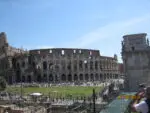Today, we usually think of the state of Greece when we hear the term Greek. But the ancient Greeks did not only settle in the territory of modern-day Greece. Instead, the ancient Greek world stretched over the entire Mediterranean and its islands but also included the coastlines of Asia Minor, the Black Sea, and even the Crimea Peninsula and the coast of Bulgaria. But these were not completely under Greek control and there was also not just one ancient Greek state.
Instead, the ancient Greeks lived in independent city-states. But how big were these Greek cities? And how many people lived in an average Greek city-state? And how do Athens and Sparta compare size- and population-wise? These questions will be answered in the following!
The average Greek city-state had a size of 19 – 38 square miles (50-100 km2), a population of roughly 3,000 inhabitants (only about 1/3 of them were citizens), and was not more than a two-days march (31 miles / 50 km) away from the sea. Sparta had a size of 3243 square miles (8400 km2) and a population of about 24,000 people (not more than 9,000 of them were full citizens). Athens had a size of 926 square miles (2400 km2) and a population of 120,000 people (including 40,000 citizens).
Speaking of these 40,000 Athenian citizens. Most of them (30,000) were needed to fully man the famous Athenian fleet. But more on that later.
Let`s now start by taking a closer look at the size of the average Greek city (and why the average Greek city was rather small)!
The Size & Population of the Average Greek City-state
The ancient Greeks lived in independent city-states (so-called Polis / Poleis) that existed all over the Mediterranean and at the coasts of Asia Minor and the Black Sea. There were more than 1,000 city-states, most of them in modern-day Greece and Asia Minor. But some were also situated in Northern Africa, Italy, Sicily, France (the city Marseille was founded by ancient Greek settlers from the city of Phocaea under the name of Massalia), and even in modern-day Bulgaria and on the Crimean Peninsula.
Most of these 1,000 Greek city-states had one thing in common: They were pretty close to the water, most city-states were not more than a two-days march (31 miles / 50 km) away from the sea. The reason for that can be found in the Geography of Greece.
The landscape of Greece was (and still is) pretty rugged so any sort of long-distance transportation on land was difficult. As a result the ancient Greeks always stayed connected to the sea and used the sea (instead of the land) for traveling.
The landscape was also the reason why the average Greek city-state was pretty small in both the size of its territory as well as in the number of inhabitants.
The territory (that means the city itself as well as the surrounding farmland) of the average Greek city-state ranged between 19 – 38 square miles (50-100 km2). The average Greek city-state did also not have more than 3,000 inhabitants of which only about 1/3 were citizens with full rights.
There was also a certain number of slaves in every Greek city-state.
So the size of most ancient Greek city-states was relatively small and the amount of farmland (and in extension the number of people who could be sustained) was pretty limited. Citizens who no longer saw a future in their hometown went on sea-based travels (remember, most Greek cities were not more than 31 miles away from the sea) to find new land for settlements. As a result of that colonization, the Greeks spread out and founded colonies all over the Mediterranean.
So the rugged landscape of Greece was split into many small patches of usable land surrounded by mountains forcing those citizens who could not see a future in their hometowns to leave their cities behind and found new colonies. That is the reason why Greek city-states exist all over the Mediterranean, in Asia Minor, and even on the coasts of the Black Sea!
However, there were also much larger city-states in ancient Greece. The two best examples are the two rivals Sparta and Athens!
The Size & Population of Sparta
So let`s start with Sparta, the military society famous for its superior army.
Sparta (both the city itself and the surrounding settlement land) was comprised of 3243 square miles (8400 km2) and had a total population of about 24,000 inhabitants. But despite its population of 24,000 Sparta never had more than 9,000 full citizens. That number decreased and in 480 BC the number had already gone down to 8000. In 370 BC only 1500 Spartiates were left. That number continued to go down until only 700 Spartiates were left in the middle of the 3rd century BC.
The full citizens of Sparta were called Spartiates. And while they were the only ones with a political say, they had always been a minority in their state. That, by the way, is also one of the reasons why Spartan males lived in barracks for large parts of their lives.
Even Aristotle identified the decline in the Spartiate population as the major reason for the downfall of Sparta and also names reasons for the decline in Spartiate population.
But in his book „Politics“* Aristotle also calculates that the settlement lands of Sparta would be able to support roughly 31,500 Spartiates (so that 1500 would meet the wealth requirements for serving as cavalrymen while the other 30,000 would meet the wealth requirements for service as Hoplites.
Here you can find out more about the Hoplites and the wealthy requirements they had to meet.
But despite the calculations of Aristotle the number of Spartiates went down instead of up. Aristotle also names reasons for the decline.
So Sparta was one of the largest Greek city-states when it comes to the total size of the city (both the city itself as well as the surrounding settlement lands) but had a relatively small number of inhabitants compared to its rival Athens. Here you can find out more about what sparked the rivalry between Athens and Sparta that would eventually lead to the Peloponnesian War.
The Size & Population of Athens
While Sparta was famous for its army, the city of Athens was mostly known for its navy. The construction of a strong navy might have been born out of necessity in the Persian Wars, but it turned Athens from a pretty unimportant city into a major political player within 5 years.
By the way, the fact that Athens relied on its navy and Sparta on its army was one of the reasons why the Peloponnesian War lasted so long. But that is a story for another time. Let`s now look at how big Athens was and how many people lived in Athens.
Athens (both the city itself and the surrounding settlement lands) was comprised of 926 square miles (2400 km2) and had a population of 120,000 people (including 40,000 citizens). 30,000 of these 40,000 Athenian citizens were necessary to fully man the entire Athenian navy.
So Athens was certainly one of the largest Greek city-states when it came to population. But it also shows that large parts of the citizens of Athens were needed to man the ships of the Athenian navy.
And while military service was one of the duties of every ancient Greek citizen (and as such not paid), Athens still gave every oarsman and Hoplite some money as a contribution to his utility costs while away at war.
Do you want to find out more about how much money each Athenian oarsman received per day of military service? Then I would like to recommend you my article here where I talk about the prices of daily goods as well as the wages in ancient Athens.
Speaking of war.
War between the individual city-states was pretty normal in ancient Greece. On average the city-state of Athens fought a war every 2 – 3 years. And no peacetime lasted longer than 10 years! And the statistics of other Greek city-states were not that much better.
But that is a story for another time. Click here for an overview of the violent history of Ancient Greece and the many wars the ancient Greek city-states fought against each other!
Take care of yourself because you deserve it. You really do.
Until next time
Yours truly
Luke Reitzer
Sources
Thucydides: The Peloponnesian War.*
Wolfgang Will: Athen oder Sparta. Eine Geschichte des Peloponnesischen Kriegs.*
Karl-Wilhelm Welweit: Sparta. Aufstieg und Niedergang einer antiken Großmacht (Stuttgart 2004).*
Jenifer Neils: The Cambridge companion to ancient Athens.*
Disclaimer: This post contains affiliate links that are identifiable by the *. If you use these links to buy something we may earn a small commission without additional cost for you. Thanks.

